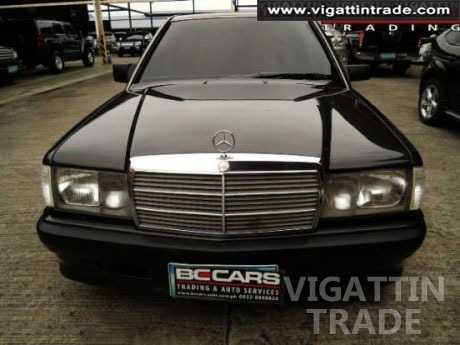1990 Mercedes Benz 190e 2.5 16valve Very Rare!!! Matic

Ad Information
Ad Description
**1990 MERCEDES BENZ 190E**
- 2.5 16valve engine cosworth
- A/T
- limited edition
- all stock except mags
- AMG magwheels
- collectors item
- very fresh in and out
- PhP 900,000 or BEST OFFER!!!
- VERY RARE!!! MUST SEE TO APPRECIATE!!!
For more inquiries contact us:
(+63)922-8888-828
(02)775-5555
or you can visit and like us on Facebook:
www.facebook.com/bccars888
*The Mercedes-Benz W201 is a compact executive car manufactured byMercedes-Benz from 1982 to 1993, positioned below the Mercedes-Benz E-Class and S-Class and marketed under variants of the Mercedes 190 nameplate.
The W201 featured a patented rear 5-link suspension, subsequently used in E and C class models, front and rear anti-roll bars, anti-dive and anti-squat geometry as well as available airbags, ABS brakes and seatbelt pretensioners.
The W201 enjoyed strong sales in Europe but fared poorly in the United States. Series production ended April 13, 1993 after the manufacture of approximately 1.8 million examples. The 190 and its variants were succeeded in the compact executive car segment by the C-Class, a newly created nameplate.
An enlarged 2.5 L engine replaced the 2.3 L in 1988. It offered double-row timing chains to fix the easily snapping single chains on early 2.3 engines, and increased peak output by 17 hp (12.5 kW) with a slight increase in torque. For the European market without catalyst (R F) the car delivered 204 bhp (150 kW). Catalyst equipped 2.5-16s produced a slightly reduced 197 bhp (147 kW). It is debated whether the 2.5 L engine was developed and built by Mercedes or Cosworth.[citation needed] Mercedes was not keen to broadcast the fact that their most sporting saloon car has an engine developed by a British company. However some cylinder heads from 2.5 L cars are stamped with the Coscast logo indicating they were cast at Cosworth's foundry just like the 2.3s. Cosworth also list the project code "WAB" for the development of the 2.5-16-valve head just as they do for the 2.3-16-valve head. Car program Top Gear predicted this 2.5 model to be one of the future classics in the car world, because of its relatively unknown history and rivalry with the (BMW M3).
With the debut of the (BMW M3 Sport Evolution), Mercedes' direct competitor, it became obvious that the 2.5-16 needed a boost for the circuit. In March 1989, the 190 E 2.5-16 Evolution debuted at the Geneva Auto Show. The Evo I, as it came to be called, had a new spoiler and wider wheel arches. Many changes were made to under-the-skin components such as brakes and suspension. There was a full SLS suspension allowing vehicle ride height to be adjusted from an interior switch. All were intended to allow the Evolution cars to be even more effective round a track.
The Evo I's output is similar to the 202 bhp (151 kW) of the "regular" 2.5-16. However this car had a redesigned engine of similar capacity but, most importantly, a shorter stroke and bigger bore which would allow for a higher rev limit and improved top-end power capabilities. Additional changes stretch to "rotating masses lightened, lubrication improved and cam timing altered". Cosworth also list a project code "WAC" for the development of the short-stroke Evolution engine.
Only 502 units of the Evolution model were produced for homologation in compliance with DTM rules. For those customers desiring even more performance, a PowerPack option engineered by AMG was available for DM 18,000. The PowerPack option included hotter camshafts, a larger diameter throttle body, more aggressive ignition and fuel management as well as optimization of the intake and exhaust systems. The net result was an additional 30 bhp (22 kW).
In March 1990, at the Geneva Auto Show, the 190 E 2.5-16 Evolution II was shown. With the success of the first Evolution model, this model's 502-unit production was already sold before it was unveiled.[citation needed] This car retailed in 1990 for USD $80,000.
The "Evo II" included the AMG PowerPack fitted to the same short-stroke 2.5 engine as the Evolution, as well as a full SLS suspension allowing vehicle ride height to be adjusted from an interior switch. An obvious modification to the Evolution II is a radical body kit (designed by Prof. Richard Eppler from the University of Stuttgart) with a large adjustable rear wing, rear window spoiler, and Evolution II 17-inch wheels. The kit served an aerodynamic purpose it was wind tunnel tested to reduce drag to 0.29, while at the same time increasing downforce. Period anecdotes tell of a (BMW) executive who was quoted as saying "if that rear wing works, we'll have to redesign our wind tunnel." The anecdote claims that (BMW) did.
As mentioned 500 were made in "blauschwarz" blue/black metallic. But the last two, numbers 501 and 502 were made in astral silver.
It is clear that these cars are now extremely rare in the collectors cars market place. Very few, if any have returned for resale in Europe as these cars are now clearly in the hands of long term collectors or are in personal storage. Of interesting fact is that a significant number of Evolution II cars were privately imported to Japan and that these cars appear to be the only units available for trade as of lately. Latest appearance in USS Tokyo auction group resulted in a wholesale price at 4,050,000 yen for a 65,000 km pristine example and this car was the third of its kind to appear in the 2010 to 2011.
Compared Ad


